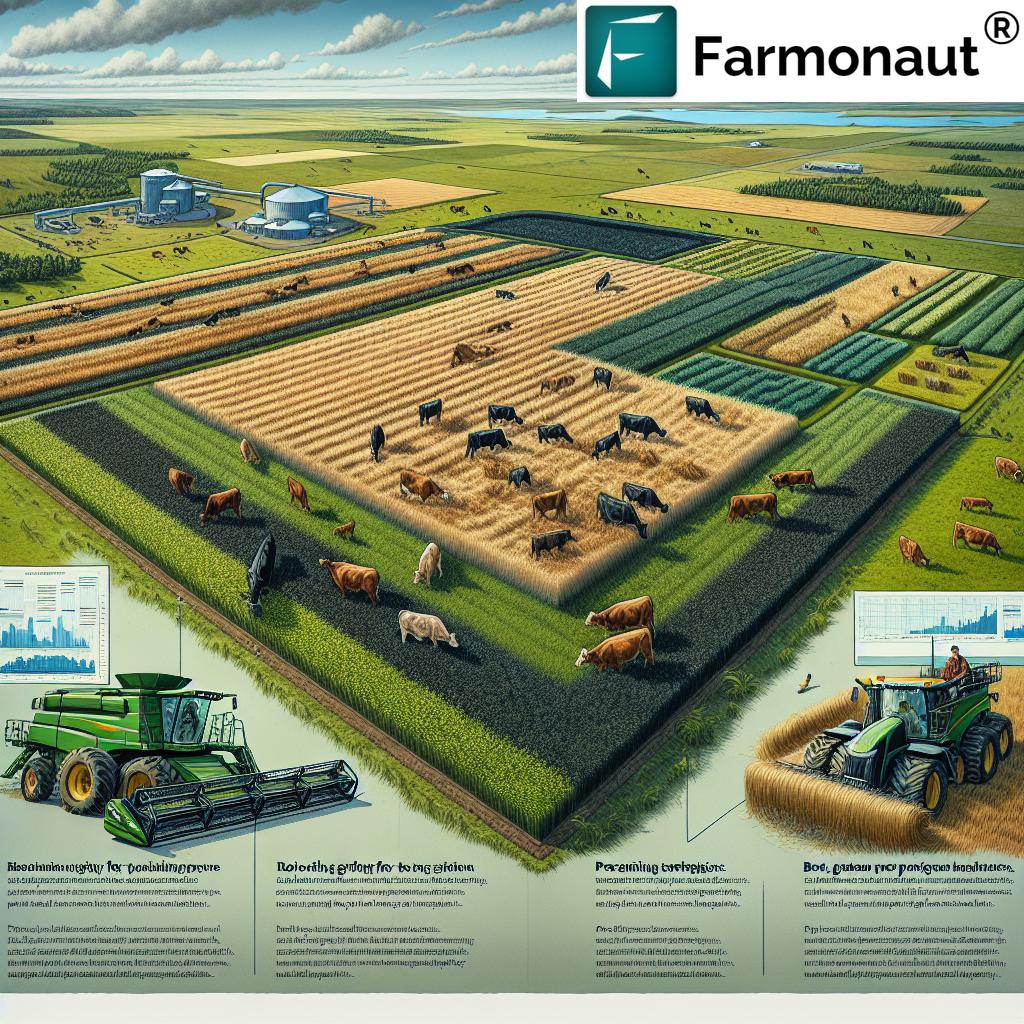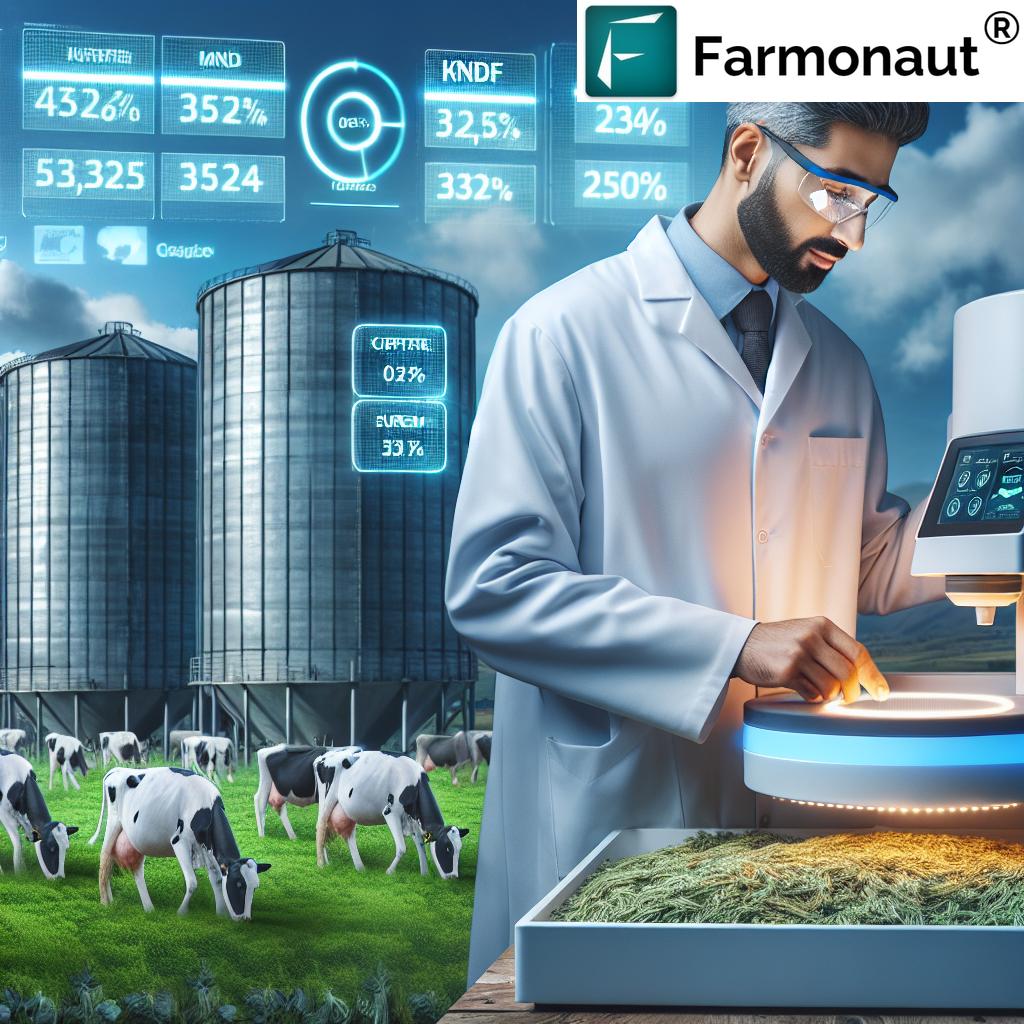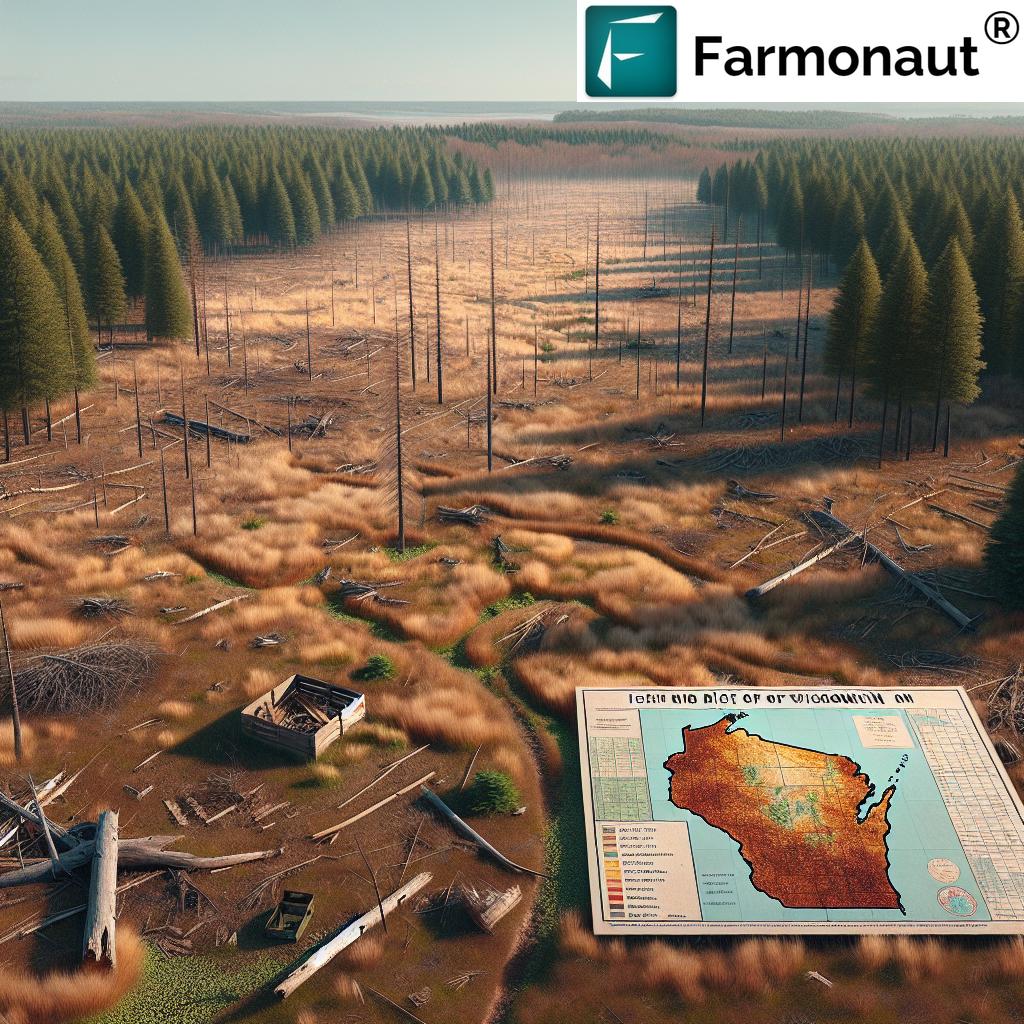Maximizing Pasture Forage Quality: Essential Strategies for Optimizing Northeast Livestock Nutrition and Farm Profitability
“Rotational grazing can increase forage utilization efficiency by up to 30%, boosting livestock productivity and farm profitability.”
In the ever-evolving landscape of Northeast agriculture, optimizing pasture forage quality has become a cornerstone for successful livestock production and farm profitability. As we delve into this crucial topic, we’ll explore innovative strategies that can revolutionize your approach to grazing management and forage utilization. Our focus will be on enhancing ruminant livestock nutrition while maximizing the economic potential of your agricultural acreage.

At Farmonaut, we understand the challenges faced by Northeast farmers in maintaining high-quality pastures and optimizing feeding strategies. That’s why we’ve developed cutting-edge satellite-based farm management solutions to assist you in this endeavor. Our technology integrates seamlessly with traditional farming practices, providing you with real-time insights into your pasture health and helping you make informed decisions.
The Importance of Pasture Forage Quality in Livestock Nutrition
Pasture forage quality is the backbone of cost-effective livestock feeding and plays a pivotal role in ruminant livestock nutrition. High-quality forage not only meets the nutritional needs of your livestock but also significantly reduces the need for expensive supplementary feeds. Let’s break down why pasture forage quality is so crucial:
- Nutrient Density: High-quality forage is rich in essential nutrients, providing your livestock with the energy, protein, and minerals they need for optimal growth and production.
- Digestibility: Better quality forage is more digestible, allowing your livestock to extract maximum nutritional value from what they consume.
- Feed Efficiency: When pasture quality is high, animals can meet their nutritional requirements with less total feed intake, improving overall feed efficiency.
- Health Benefits: Nutrient-rich pastures contribute to better animal health, reducing the incidence of metabolic disorders and improving reproductive performance.
By focusing on pasture forage quality, we can significantly enhance livestock production while minimizing input costs. This approach aligns perfectly with our goal of optimizing feeding strategies for maximum farm profitability.
Rotational Grazing: A Game-Changer for Pasture Management
One of the most effective grazing management practices for improving pasture forage quality is rotational grazing. This method involves dividing pastures into smaller paddocks and moving livestock between them at regular intervals. The benefits of rotational grazing are numerous:
- Improved Forage Utilization: By controlling grazing periods, we ensure that livestock consume forage at its optimal nutritional stage.
- Enhanced Pasture Recovery: Rest periods between grazing allow plants to regrow and replenish their energy reserves, leading to more resilient and productive pastures.
- Increased Carrying Capacity: Well-managed rotational grazing can increase the number of animals a pasture can support.
- Soil Health Improvement: This practice promotes better root development and increases organic matter in the soil, enhancing overall pasture health.
Implementing rotational grazing requires careful planning and monitoring. This is where Farmonaut’s satellite-based monitoring can be invaluable, providing real-time data on pasture conditions to help you make informed decisions about when to move your livestock.
Optimizing Hay Meadows and Aftermath Grazing
Hay meadows are a crucial component of Northeast livestock farming, providing essential winter feed. Proper management of these areas can significantly impact your farm’s profitability. Here are some strategies to optimize hay meadows:
- Timing of Harvest: Cut hay at the optimal stage of maturity to balance yield and nutritional quality.
- Fertilization: Implement a soil testing program to ensure proper nutrient levels for maximum hay production.
- Weed Control: Regular monitoring and control of weeds can significantly improve hay quality.
- Aftermath Grazing: Utilize the regrowth after hay harvest for grazing, maximizing the use of your agricultural acreage.
Aftermath grazing, when done correctly, can provide high-quality forage late in the season while also helping to control weeds and improve soil health. It’s an excellent example of how we can optimize our agricultural land use for multiple purposes.
“Well-managed pastures can reduce feed costs by 20-40%, significantly improving overall farm economics in the Northeast.”
Assessing Pasture Conditions: The Key to Timely Management
Regular assessment of pasture conditions is crucial for maintaining high forage quality. Here’s how we can effectively monitor our pastures:
- Visual Inspections: Regular walks through the pasture to observe plant health, density, and species composition.
- Forage Testing: Periodic sampling and analysis of forage to determine its nutritional content.
- Satellite Monitoring: Utilizing advanced technology like Farmonaut’s satellite imagery to track pasture health and growth patterns over time.
- Soil Testing: Regular soil analyses to ensure optimal nutrient levels for forage growth.
By combining these assessment methods, we can gain a comprehensive understanding of our pasture’s health and make timely management decisions. Farmonaut’s satellite-based crop health monitoring can provide valuable insights into vegetation health (NDVI) and soil moisture levels, helping you optimize your grazing management practices.

Balancing Nutritional Needs: Customizing Grazing Strategies
Different livestock have varying nutritional requirements, and these needs change throughout their life cycle. To maximize pasture forage quality and ensure optimal livestock nutrition, we need to tailor our grazing strategies accordingly:
- Lactating Dairy Cows: Require high-energy, high-protein forage. Implement intensive rotational grazing with frequent moves to fresh pasture.
- Beef Cattle: Can utilize a wider range of forage qualities. Consider a less intensive rotational system with longer grazing periods.
- Sheep and Goats: Often prefer browsing and can be used to control weeds and improve pasture diversity.
- Young Stock: Require high-quality forage for growth. Prioritize these animals on the best pastures.
By matching grazing strategies to livestock needs, we can optimize both pasture utilization and animal performance. Farmonaut’s Jeevn AI Advisory System can provide personalized recommendations based on your specific livestock and pasture conditions, helping you make informed decisions about grazing management.
Enhancing Soil Health for Improved Forage Quality
The foundation of high-quality pasture forage lies in healthy soil. Implementing practices that enhance soil health can lead to significant improvements in forage quality and quantity:
- Nutrient Management: Regular soil testing and targeted fertilization to maintain optimal nutrient levels.
- pH Balancing: Lime application to maintain proper soil pH for optimal nutrient availability.
- Organic Matter Enhancement: Encourage root growth and incorporate organic materials to improve soil structure and water-holding capacity.
- Preventing Soil Compaction: Avoid grazing on wet soils and implement a rotational system to allow for recovery periods.
By focusing on soil health, we create a strong foundation for sustainable pasture management and high-quality forage production. Farmonaut’s satellite-based monitoring can help track changes in soil health over time, allowing for more precise management decisions.
Integrating Technology for Precision Pasture Management
In today’s digital age, leveraging technology can significantly enhance our pasture management strategies. Farmonaut’s advanced satellite-based farm management solutions offer a range of tools to optimize your pasture and livestock management:
- Real-time Crop Health Monitoring: Use satellite imagery to track pasture health and growth patterns, allowing for timely interventions.
- AI-based Advisory Systems: Receive personalized recommendations for grazing management based on your specific pasture conditions and livestock needs.
- Weather Forecasting: Access accurate weather predictions to plan grazing rotations and hay harvesting more effectively.
- Resource Management Tools: Optimize the use of your agricultural acreage by efficiently managing pastures, hay meadows, and other farm resources.
By integrating these technological solutions into your farm management practices, you can make more informed decisions, leading to improved pasture forage quality and increased farm profitability.
Explore Farmonaut’s innovative solutions:
Maximizing Economic Benefits Through Smart Pasture Management
Implementing these strategies for maximizing pasture forage quality can lead to significant economic benefits for Northeast livestock farms:
- Reduced Feed Costs: High-quality pastures can significantly decrease the need for expensive supplementary feeds.
- Improved Livestock Performance: Better nutrition leads to increased milk production, faster weight gain, and improved reproductive performance.
- Enhanced Farm Sustainability: Proper pasture management leads to healthier ecosystems and more resilient farming systems.
- Diversified Income Streams: Well-managed pastures can potentially open up opportunities for value-added products or agritourism.
By focusing on pasture forage quality, we not only improve the health and productivity of our livestock but also create a more profitable and sustainable farming operation.
Comparative Analysis of Grazing Management Strategies
| Grazing Strategy | Forage Quality Impact | Livestock Nutritional Benefits | Soil Health Improvement | Feed Cost Reduction | Farm Profitability Increase |
|---|---|---|---|---|---|
| Continuous Grazing | 5-10% | Low | 0-5% | 0-10% | 0-5% |
| Rotational Grazing | 20-30% | High | 15-25% | 20-30% | 15-25% |
| Strip Grazing | 25-35% | Very High | 20-30% | 25-35% | 20-30% |
| Mob Grazing | 30-40% | High | 25-35% | 30-40% | 25-35% |
This table clearly illustrates the potential benefits of adopting more intensive grazing management strategies. While continuous grazing offers minimal improvements, strategies like rotational and strip grazing can significantly enhance forage quality, soil health, and overall farm profitability.
Implementing Year-Round Forage Planning
To ensure consistent high-quality forage availability throughout the year, it’s crucial to implement a comprehensive forage planning strategy:
- Seasonal Forage Mapping: Plan for different forage types to be available at various times of the year.
- Stockpiling Forage: Allow certain pastures to grow for use during winter months.
- Cover Crops and Annual Forages: Integrate these into your rotation to fill gaps in perennial pasture production.
- Hay and Silage Production: Strategically harvest excess forage for use during low-production periods.
By implementing a year-round forage plan, we can ensure a steady supply of high-quality feed for our livestock, reducing the need for purchased feeds and improving overall farm economics.
Monitoring and Adjusting: The Key to Continuous Improvement
Successful pasture management is an ongoing process that requires constant monitoring and adjustment. Here’s how we can ensure continuous improvement in our pasture forage quality:
- Regular Forage Testing: Conduct periodic tests to track changes in forage quality throughout the season.
- Livestock Performance Monitoring: Keep detailed records of animal health, growth rates, and production levels.
- Pasture Growth Rates: Use tools like grazing sticks or Farmonaut’s satellite monitoring to track pasture growth and recovery rates.
- Economic Analysis: Regularly assess the economic impact of your grazing management strategies on overall farm profitability.
By consistently monitoring these factors and making timely adjustments, we can continually refine our pasture management practices for optimal results. Farmonaut’s advanced monitoring tools can provide valuable data to support this process, helping you make data-driven decisions for your farm.
Embracing Sustainable Practices for Long-Term Success
As we strive to maximize pasture forage quality and farm profitability, it’s essential to consider the long-term sustainability of our practices. Here are some key considerations:
- Biodiversity Enhancement: Encourage a diverse mix of plant species in your pastures to improve resilience and nutritional variety.
- Carbon Sequestration: Well-managed pastures can act as significant carbon sinks, contributing to climate change mitigation.
- Water Management: Implement strategies to improve water retention and prevent runoff, enhancing pasture productivity and environmental health.
- Wildlife Habitat: Create areas within your pastures that support local wildlife, contributing to overall ecosystem health.
By adopting these sustainable practices, we not only improve our pasture forage quality but also contribute to the long-term health of our farms and the surrounding environment. Farmonaut’s carbon footprinting feature can help you track your farm’s environmental impact and identify areas for improvement.
Conclusion: A Path to Thriving Northeast Livestock Farms
Maximizing pasture forage quality is a multifaceted approach that requires careful planning, consistent management, and a willingness to adapt. By implementing the strategies discussed in this article, Northeast livestock farmers can significantly enhance their ruminant livestock nutrition, optimize their feeding strategies, and boost overall farm profitability.
Remember, every farm is unique, and what works best will depend on your specific circumstances. The key is to start implementing these practices, monitor your results, and continually refine your approach. With tools like Farmonaut’s satellite-based farm management solutions at your disposal, you have the power to make data-driven decisions that can transform your pasture management and elevate your farm’s success.
As we look to the future of Northeast agriculture, it’s clear that optimizing pasture forage quality will play a crucial role in creating sustainable, profitable, and resilient livestock farms. By embracing these strategies and leveraging cutting-edge technology, we can ensure a thriving future for our farms and our communities.
Explore Farmonaut’s API solutions:
FAQ Section
Q1: How often should I rotate my livestock between paddocks?
A1: The frequency of rotation depends on factors like pasture growth rate, livestock needs, and weather conditions. Generally, rotations can range from daily to weekly. Monitor forage height and quality to determine the optimal timing for your specific situation.
Q2: What are the best forage species for Northeast pastures?
A2: A mix of cool-season grasses (e.g., orchardgrass, timothy, fescue) and legumes (e.g., white clover, red clover) typically works well in the Northeast. Consider your specific soil type, climate, and livestock needs when selecting species.
Q3: How can I improve pasture productivity during dry periods?
A3: Implement drought-tolerant species in your pasture mix, practice rotational grazing to prevent overgrazing, and consider irrigation if feasible. Farmonaut’s soil moisture monitoring can help you make timely decisions during dry periods.
Q4: What’s the best way to measure pasture forage quality?
A4: Regular forage testing through a certified laboratory is the most accurate method. However, visual assessments, measuring forage height, and using tools like NDVI from Farmonaut’s satellite imagery can provide valuable ongoing insights.
Q5: How can I balance grazing with hay production on my farm?
A5: Plan your grazing rotation to allow some paddocks to grow for hay production. Use Farmonaut’s satellite monitoring to track growth rates and determine the optimal time for hay cutting while maintaining sufficient grazing areas for your livestock.




















